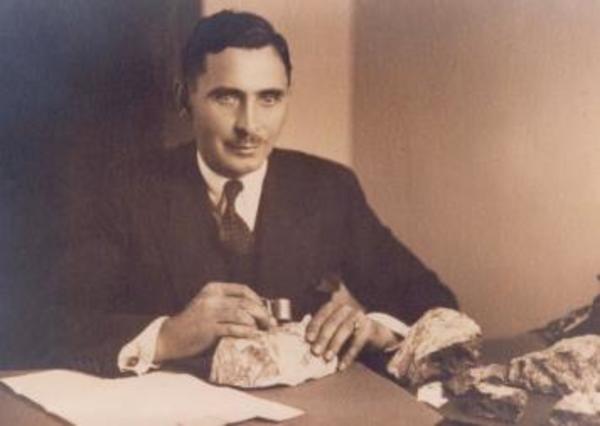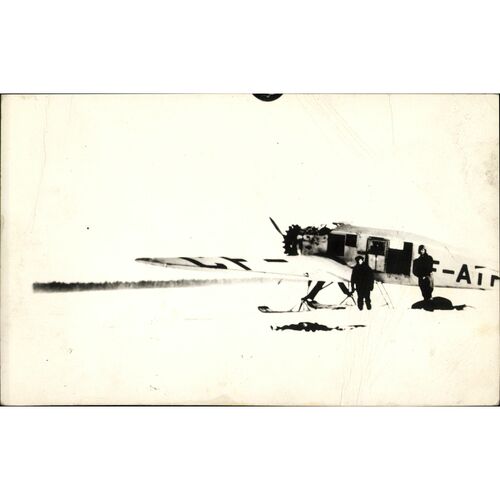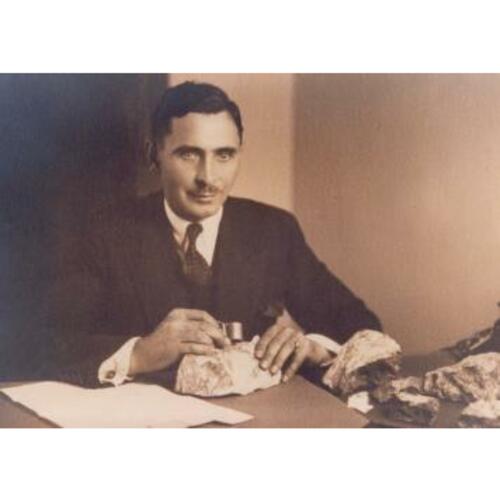
Source: Link
SISCOE, STANLEY EDWARD (named at birth Stanisław Szyszka), miner, prospector, and businessman; b. 23 Oct. 1891 in Nowa Wieś in the district of Krotoszyn (Poland), son of Frank Szyszka and Frances Kurzyńska; m. 1 Aug. 1924 Lorette Lessard in Montreal, and they had two daughters; d. sometime between 23 and 26 March 1935 on the frozen surface of Lake Matchi-Manitou, Que.
Stanisław Szyszka received his early education in what was then the German province of Posen. On 20 Nov. 1907 he sailed from Antwerp, Belgium, on board the Mount Temple destined for Saint John, N.B. He intended to continue on from there to Chicago, where he was to stay with an aunt and attend school. He did not, however, reach either destination. On 2 December, during a snowstorm, his ship went aground on Ironbound Island off the coast of Nova Scotia. A basket on a cable tied to the island’s cliffs was used to transfer the women and children from the ship to the shore. The male passengers landed on the island in lifeboats and they all spent the night “frightened, wet and cold,” according to a local newspaper. The following morning the 633 passengers were evacuated to Halifax by ship. The Lady Laurier’s passenger list mentions that Szyszka had $25 and was a “general labourer.”
Szyszka travelled to Cobalt, Ont., where his uncle lived, and gained employment as a miner, took night classes, and sometimes served as a translator for fellow members of the town’s small Polish community. He worked for a time in the Nipissing Mine [see David Fasken*] and the Hollinger Mine [see Benjamin Hollinger*].
By 1910 Szyszka was an office messenger for a mining company. He began to prospect in northern Ontario and continued his prospecting trips to the Abitibi region of Quebec. In the spring of 1913 he teamed up with three other men and travelled by train to Latulipe (Amos), and then by boat up the Harricana River to the shores of Lake De Montigny. They prospected during the summer and registered claims on an island in the lake, which would become known as Siscoe Island, first informally and then officially in 1968 (Szyszka also used an anglicized name, Stanley Edward Siscoe). The lake would sometimes also be unofficially called Siscoe Lake. The group returned to Cobalt in the autumn and worked in the local mines. Since two of its members did not wish to return to the island, Siscoe purchased their claims, and on 15 May 1914 he went back to prospect. In the fall he was once more in Cobalt, where he was obliged to register with the local police as an enemy alien since World War I had broken out and he was a citizen of Germany. In October that year he moved to Timmins [see Noah Anthony Timmins], where he worked in a hotel during the winter, and he prospected on the island in the summer with other Poles. He soon formed the Siscoe Mining Syndicate with fellow Polish miners from Timmins and Cobalt to work the claims there. His brother Peter (Piotr), who had immigrated in 1911, died from the Spanish flu in Amos on 24 Nov. 1918 at the age of 27.
During the summer of 1919 a shaft was sunk and a gallery to the gold veins was excavated on Siscoe Island. Four years later high-quality gold was discovered in what was named the “Siscoe vein.” Siscoe sought financial support from a variety of sources, and on 23 May 1923 he incorporated Siscoe Gold Mines Limited, which would also mine silver. The new company succeeded the syndicate and the British Minerals Corporation Limited, with which Siscoe had made a conditional funding deal that elapsed before the mine was developed. The capital stock was one million dollars in an equal number of shares.
In April 1923 Siscoe moved from Timmins to Amos, and a little over a year later he married Lorette Lessard in a Roman Catholic ceremony at the Saint-Clément parish church, in Montreal’s Viauville neighbourhood. She would become involved with her husband’s mining business.
Work on Siscoe Island continued; the land was cleared and machinery was installed to extract gold ore. Siscoe travelled to Montreal and other centres to purchase supplies and equipment. He was assisted by one of his brothers, Joseph (Józef), and his partner, Joseph (Józef) Samulski.
On 8 June 1927 Siscoe submitted his application for a certificate of naturalization to the Canadian government. In the document Joseph-Ovide Germain, who became mayor of Amos the following year, describes him as “an honest and reliable man.” His naturalization was made official on 12 Dec. 1928.
By then Siscoe’s enterprise had expanded considerably: the capital stock of Siscoe Gold Mines Limited increased to three million shares in 1924 and to four million in 1928. The mill for processing the ore went into operation on 8 January the following year and the first gold ingot produced in Quebec was poured at that time. New buildings and infrastructure were constructed on Siscoe Island, including a larger bunkhouse, a recreation hall, three houses, a school, a fire hall, and a water-distribution system. The riverboat Siscoe maintained a regular ferry service between Amos and the island for freight and passengers during the summer months.
In 1929 Siscoe was vice-president and director of Siscoe Gold Mines with offices in Montreal and Amos. The following year he was president of Stanley Siscoe Extension Gold Mines Limited (incorporated 6 Aug. 1929), which owned a property on the mainland across from Siscoe Gold Mines Limited. Both companies had offices in Montreal, where Siscoe lived from at least 1931, visiting his eponymous island with the other directors of Siscoe Gold Mines Limited when required. In March 1930 the capital stock of Siscoe Gold Mines Limited was increased to five million shares with a par value of one dollar per share. That company paid a dividend in March 1932, which was the first time a lode gold mine in Quebec had done so. It proved to have good-quality gold ore, which made it particularly susceptible to high-grading (theft). Other problems included mining accidents, isolation from larger centres, and danger from forest fires. Siscoe’s success stimulated the development of mines in the area around Val-d’Or and Cadillac (Rouyn-Noranda). He continued to seek investors for his mining projects. In 1933 he acquired the rights to a property near Wawa, Ont., and established Stanley Gold Mines Limited to develop the site. He called it the Stanley Gold Mine and began to boost it as his personal project. The mine provided employment for approximately 50 miners. He applied for membership in the Canadian Institute of Mining and Metallurgy in 1930, but his qualifications were questioned and he was admitted only as an associate member on 7 Feb. 1934.
Siscoe was not necessarily easy to get along with. According to his partner, he was a difficult person, prone to sarcasm. In his memoirs, Samulski mentions that he and Siscoe would sometimes get into fist-fights that resulted in bloody noses. From the first years the president and board of directors of Siscoe Gold Mines Limited were embroiled, directly and indirectly, in a number of business transactions involving mining shares that resulted in litigation and street rumours. These disputes included Lorette, and in November 1934 she took legal action against her husband during a quarrel about property rights and the alleged illegal sale of shares they held in common.
Siscoe did, however, have a softer side. He had a great appreciation for beauty and particularly loved flowers. Horseback riding, fishing, and boating were among his favourite activities, and he travelled a great deal. He was no doubt among the first Canadian businessmen who preferred to journey by plane. On 9 Sept. 1929 he had flown from Saint-Hubert near Montreal to New York. In 1930 and 1932, with his wife and daughters, he visited family in Poland, where he purchased a farm with Samulski. Two years later he vacationed with his family in Bermuda, and in early 1935 he returned to Europe.
On 19 March that year Siscoe chartered a plane from Canadian Airways [see James Armstrong Richardson] in Montreal to fly him to Siscoe Island. It was forced down near Lake Matchi-Manitou by a storm. He and the pilot, Tom Wrathall, took refuge in an abandoned trapper’s cabin to wait it out. When the weather cleared, however, the plane could not fly. After four days, their food supply was almost completely exhausted. Siscoe became impatient and, against his companion’s advice, decided to leave on foot to seek aid. Wrathall was rescued on 25 March. Siscoe was found the next day, frozen to death, in his business suit, on the surface of Lake Matchi-Manitou. His widow would sue the airline and receive some compensation. He was buried in the Notre-Dame-des-Neiges cemetery in Montreal. Reports of his decease appeared in various publications, including Polish-language newspapers in both Canada and the United States.
At the time of his death, Siscoe was a director of Siscoe Gold Mines Limited and Northern Securities Limited and president of Stanley Siscoe Extension Gold Mines Limited. Between 1929 and 1936 the Siscoe mines generated $8.7 million in revenue and $4 million in profit. The mineral deposits discovered, however, ran out after 20 years of exploitation, while the other mining companies in the region excavated deeper and found more. Siscoe Gold Mines ceased production in 1949. Following his death, mining operations at the Stanley Gold Mine near Wawa had been halted, but they were renewed in 1936. Stanley Gold Mines Limited declared bankruptcy in 1937 and all work was suspended in December of that year.
Aside from the island that bears Siscoe’s name, reminders of his life can be found in Val-d’Or, where a street was named after him in 1987. Another would be named after his wife two decades later, and in 1981 Lorette Island in the Harricana River just north of La Motte was entered into gazetteers.
In obituaries Stanley Edward Siscoe was described as a mining pioneer and a leading figure in the industry in Quebec. Regarded as sharp and shrewd, he made an impressive rise to wealth for a Polish immigrant in early-20th-century Canada, especially considering that he arrived as a “general labourer.”
Daniel Saint-Germain published a novel on Stanley Edward Siscoe’s last days: Sept jours dans la vie de Stanley Siscoe (Gatineau, Québec, 2005).
BANQ-Q, E4, 1960-01-005/135, libro 108, ff.166, 208; E16, 1960-01-035/281, dossier no.2673. LAC, MG28-I394 (Canadian Instit. of Mining and Metallurgy: national office fonds, membership files), vol.47, file no.64 (Siscoe, Stanley E.); “Naturalization records, 1915–1951,” Stanley Siscoe: www.bac-lac.gc.ca/eng/discover/immigration/citizenship-naturalization-records/naturalized-records-1915-1951/Pages/introduction.aspx (consulted 5 May 2020); R1206-142-0 (Saint John ships’ manifests), mfm. T-508, Mount Temple; RG42-C-1, vol.1046, file no.80-S49 (Steamship inspection service – ship Siscoe). L’Abitibi (Amos, Québec), 29 janv., 12 févr., 27 mai, 3 juin 1920. Ameryka-Echo [America-Echo] (Toledo, Ohio), 14 April 1935. Gazeta Katolicka w Kanadzie [Catholic Gazette in Canada] (Winnipeg), 27 March 1935. Gazette (Montreal), 29 June 1935. La Gazette du Nord (Amos), 20 sept. 1923; 1 mars 1929; 9 janv., 22 juin 1930; 13 nov. 1931; 4 mars 1932; 31 août 1934; 29 mars 1935. Globe, 9 Jan. 1930, 28 May 1934, 27 March 1935. Morning Chronicle (Halifax), 3 Dec. 1907. New York Times, 3 Dec. 1907, 27 March 1935. Northern Miner (Toronto), 3 Jan., 28 Feb. 1929; 28 March 1935; 1 April 1987. Ottawa Journal, 22 Dec. 1934, 26 June 1936, 6 March 1969. Polonia (Montreal), 31 March 1935. La Presse, 26 mars 1935. Toronto Daily Star, 11 Oct. 1933; 4 Jan., 26 Nov. 1934; 26 March 1935. Maurice Asselin et al., Histoire de l’Abitibi-Témiscamingue, sous la dir. d’Odette Vincent (Sainte-Foy [Québec], 1995). Canadian Mining and Metallurgical Bull. (Montreal), no.272 (December 1934): 571; no.276 (April 1935): 182–83. Directory, Montreal, 1934. Ont., Dept. of Mines, Annual report, 1935, pt.1: 141, and pt.8: 76–77. L. T. Postle and W. F. Brown, “Mining at Siscoe,” Canadian Mining Journal (Toronto), 57 (1936): 482–92. Que., Dept. of Colonization, Mines and Fisheries, Bureau of mines, Annual report, 1926; Dept. of Mines, Annual report, 1930, and 1935, pt.A. Répertoire des mariages de la paroisse Saint-Clément de Viauville de Montréal, 1899–1986, Raymond Bélanger et Raymond Lebeau, compil. (Ottawa, 1987). A. H. A. Robinson, Gold in Canada, 1935 (3rd ed., Ottawa, 1935). Józef Samulski, Pamiȩtnik emigranta polskiego w Kanadzie [A memoir of a Polish emigrant] (2v., Wrocław, Poland, 1978–82). D. G. Sinclair et al., Mines and metallurgical works of Ontario in 1933 (Toronto, 1934), 34. Standard dict. of Canadian biog. (Roberts and Tunnell), vol.2. Gilbert Tardif, La petite histoire de Val d’Or, 1935–1985 (Val-d’Or, Québec, 1989). B. F. Townsley, Mine-finders: the history and romance of Canadian mineral discoveries (Toronto, 1935).
Cite This Article
Myron Momryk, “SISCOE, STANLEY EDWARD (Stanisław Szyszka),” in Dictionary of Canadian Biography, vol. 16, University of Toronto/Université Laval, 2003–, accessed March 31, 2025, https://www.biographi.ca/en/bio/siscoe_stanley_edward_16E.html.
The citation above shows the format for footnotes and endnotes according to the Chicago manual of style (16th edition). Information to be used in other citation formats:
| Permalink: | https://www.biographi.ca/en/bio/siscoe_stanley_edward_16E.html |
| Author of Article: | Myron Momryk |
| Title of Article: | SISCOE, STANLEY EDWARD (Stanisław Szyszka) |
| Publication Name: | Dictionary of Canadian Biography, vol. 16 |
| Publisher: | University of Toronto/Université Laval |
| Year of revision: | 2021 |
| Access Date: | March 31, 2025 |




